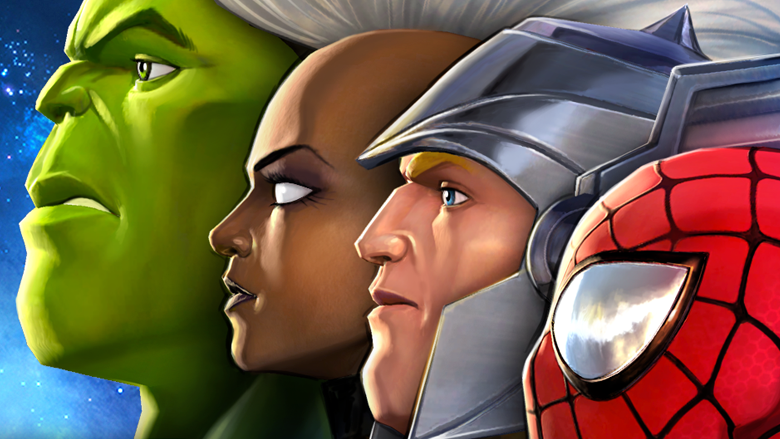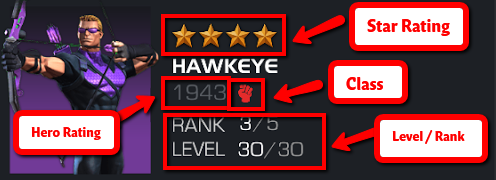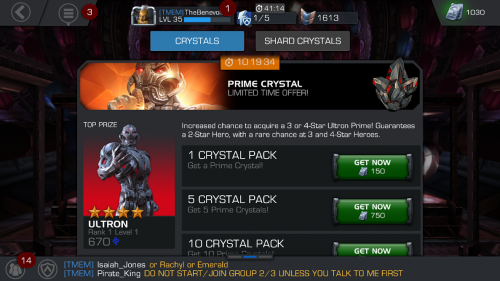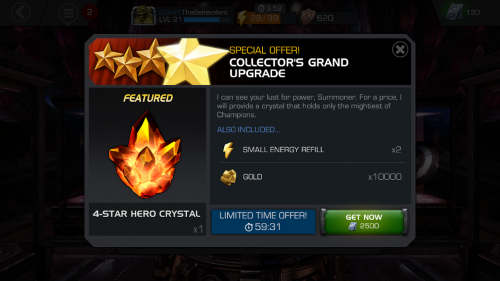How did Kabam's Contest of Champions earn $100 million in 7 months?
Vinayak Sathyamoorthy, Senior Product Manager at Zynga, analyzed in detail the reasons why Kabam’s Contest of Champions game has gained popularity. We share the translation.
Contest of Champions is an integral part of Kabam’s overall strategy for creating AAA titles for mobile, and this strategy is already bearing first fruits. Last summer, Kabam reported that Contest of Champions brought the company $100 million in revenue faster than other games before. And that’s before the game even launched in China.
Contest has brought a pleasant variety to the top ten highest-grossing App Store titles, which for quite a long time consisted of match-3 and strategies.
How did Contest of Champions succeed? To begin with, I will explain how the game works (game cycle, management, character design), and then I will tell you about the 4 main ways in which Contest of Champions is monetized. And we will conclude with a conversation about how social features help the success of the game.
Game cycle
The beginning of the game is quite simple – the player takes part in “Story Quest”, where he fights against the computer to get resources, upgrade characters with their help and gain access to new champions.
Plot task map
The plot task itself consists of a chain of battles, after each of which the player receives a reward, and the final, where the “highest” reward is given. Each battle takes away energy, which is replenished after a waiting period or for hard currency.
Resources
To upgrade a character, gold (Gold) or ISO-8 is required. These two resources are used to level up the champion, which increases the attack and defense power. Improved characters allow the player to fight a stronger opponent. The twentieth level is the ceiling, after reaching which the player must increase the rank of the character, which requires a resource called “catalyst” (Catalysts).
To collect new champions, the player uses a premium currency – “units”. This currency is quite freely distributed during the first story tasks, but the further it goes, the more difficult it is to get it. For units, the player buys “crystals” (Crystal Packs), which open access to new heroes. Crystals are a local analogue of gacha, they give the player the opportunity to get one of the “mysterious” champions, from rare to common.
In addition to the story tasks, the game has Daily Quests, which are updated every 24 hours and are the main source of the catalyst – a resource that is needed to increase the rank of the character.
Meta goals
In Contest of Champions, the player’s goal is to collect all the champions and upgrade them so as to take a leading position among other players. To this end, the player takes part in various tasks and events, where he collects the necessary resources.
As in strategies like Clash of Clans, the player first fights not against other users, but against the computer (in story and daily tasks), which makes it possible to understand the game at his own pace. Other game modes, such as “conflicts” (Duels), “battles with the enemy” (Versus) or “tasks for the alliance” (Alliance Quests), appear later when the user has already mastered the game.
Control/Gameplay
Swipes and taps
Management is reduced to two gestures: swipe and tap. Swipes always imply movement, and if you swipe to send a character towards the character of the spoiler, then he will go on the attack. Taps are assigned more functions. The screen is divided into two parts, and taps on the left half force the character to put a block, and taps on the right half – to attack.
The experience points that the player receives for each battle are accumulated in the “Special attack meter”. If you press the “Special Attack button” at the right moment, it will increase the attack power of the character. The animation of a special attack is also different for each hero (for example, a storm will fly into the air and cause lightning to strike the opponent).
The complex console control was adjusted to the mobile
The Contest developers did not bother with jumping, kicking, tripping, combos and so on. It may seem that it’s boring without them, but in fact you get along fine with what you have.
An element of strategy in a combat game
Although it seems that the user does not have many opportunities, since the choice of attacks is limited, there is still a place for strategic planning in the action. The player can choose at what point to use a special attack – when the measure is only partially filled or when it is 100% full. And the more the measure is filled, the stronger the attack. The opponent cannot defend against a special attack, so it is especially important in the match.
Some special attacks have characteristic properties. For example, Vision steals the opponent’s energy from the measure of a special attack, and the Juggernaut becomes invulnerable to enemy attacks within a few seconds. Blocks play a crucial role in defense, but they can be broken if you use a strong Attack. At the same time, the player becomes vulnerable when using a strong attack, which can also be used. Learning such subtleties and planning attacks is very interesting.
Character design
The whole game is built around collecting champions, which means that the appearance of these champions is especially important, since since the player is invited to collect a large collection of characters, each of them should have their own unique features so that they are interesting to collect.
Category (Star Rating)
The character category ranges from one star to five stars. The category affects how much a character can be upgraded. For example, I raised my three-star Storm rating (hero rating) to 1600. But the hero rating of a four-star character can be improved to 3000.
Rating (Hero Rating)
The rating is responsible for health points and attack points. When the champion’s rating increases, health points and attack power increases.
Classes (Classes)
The champions are divided into six classes: “cosmic” (cosmic), “strong” (skill), “technological” (tech), “mutants” (mutant), “scientific” (science) and “mystical” (mystic). Every champion has a class that is stronger than him, and a class that is weaker. For example, the technological champion (Iron Man) is stronger than the mutant (Wolverine), but weaker than the space champion (Thor). When a player starts a match, part of the strategy is to choose the right class.
Levels and ranks
The desire to grade a champion is an essential part of a player’s motivation. There is a multi-step approach to improving the characters in the game. As already mentioned, players level up the character with gold and SO-8, and the rank increases with the help of a catalyst. After the character’s rank has grown, his level can be raised again to a certain limit.
Signature Abilities
Each champion has his own crown abilities that help to attack or defend. The above example is a Vision that steals energy from the measure of an opponent’s special attack.
4 ways of monetization
Method #1: gacha
The only way to get new champions is crystals, a local variant of gacha. In Contest, the key part of the game cycle is that the player gives units (the game’s hard currency) – and receives them for participating in daily tasks and other game modes. The system works because players spend units in large quantities on crystals in the hope of getting four-star champions.
Crystal Sets
Every attempt is a winning one
Crystals contain characters of various classes and different rarity. By opening the crystal, the player works for a meta-goal – collects a collection of champions. Of course, everyone would prefer to have a four-star Iron Man or a Star Lord. But this does not mean that any other option is a disappointment. If this were the case, then users would immediately spend some amount of money, and then quickly “fall off”. But here everything is different.
A one-star champion is not interesting in itself, but you can always sell it and get back the spent gold and ISO-8, which will be useful to upgrade the characters. There are still “crystal fragments” from the sold champions, which can then be combined with each other to get new champions. So you can sell a two-star champion to get a three-star, and sell a three-star to get a four-star.
Getting the same champion from the crystal twice is actually one of the most enjoyable moments in the game. The player receives gold and ISO-8 in large quantities, and duplicates are the only way to unlock the crown abilities. When I came across a duplicate of the three-star Storm, I got so much ISO-8 that it was enough for me to immediately raise the champion’s level from 17 to 25 (which otherwise would have taken days, if not weeks of battles). In addition, I unlocked her crown ability “Conduit” (Conduit), which doubles the damage inflicted on the enemy during a special attack.
A big win is a rarity
The probability that there will be a four-star champion in the crystal is the main reason to buy these crystals. That’s the whole point of gacha. At the same time, as it is easy to guess, large winnings in the Contest happen. But rarely.
Data received from hundreds of players (as well as the cost of special offers for the purchase of four-star champions) indicate that four-star champions fall out extremely rarely, in isolated cases. But when this happens, the news about it appears in the news line of the alliance to which the player belongs. And here everything is the same as in a casino: after a big win is announced out loud, you get the feeling that your own chances of success have also increased.
For a complete collection , the player is rewarded
As mentioned several times, a key part of the meta-game is to collect champions. And Contest confirms this by rewarding those who collect a full set of heroes.
Firstly, collections increase the “Class Bonus” (Class Bonus). This means that for the battle with the mutant champion, I can choose a hero belonging to the technical class, which increases my chances of winning. If you choose the right class, then my rating (that is, attack points and health) increases, and the enemy’s rating drops.
Secondly, if you properly combine two characters together when you start a story task, then this makes it possible to create a “Synergy Bonus”. For example, if I combine Captain America and Iron Man, I will get a team bonus, which again increases the rating. Finally, as already mentioned, unique heroes have unique crown abilities, which forces the player to collect all new champions.
The necessary champion will not necessarily appear from the crystals, so keep buying!
Crystals only give a chance to get a certain hero, but they do not guarantee that the player will definitely get it. So if you want a special Magneto, you buy a crystal. If you want a Spider-Man symbiote, you buy a crystal.
The only guaranteed way to get a champion is when a new character appears in the game. To do this, you need to fight in a battle against the enemy (Versus) and at the end get a certain rank. The champion will go to 5-10% of the players who got into the world top event as a result.
Method #2: events and new champions
New champions are the most important part of the content updates in Contest. This approach increases engagement, and, accordingly, monetization.
As a rule, when new champions appear in the Contest, they are advertised in all available ways to create a stir around them. The release of new champions is accompanied by the release of new tasks (where new heroes appear as opponents) and the appearance of new crystals. These crystals are available for a limited amount of time, and you can’t just buy them. Therefore, their cost is 50% higher than usual.
Soon after the appearance of new crystals, new champions take part in special battles with the enemy. This lasts for 2-3 days, and during this time you can try to win a new champion. Here the Contest is monetized by selling numerous bonuses (which you can get if you win, and which are just so hard to get, it’s easier to pay) and replenishing energy (one champion is required for each battle, after which he becomes unavailable for 2 hours).
At the end of the current battle, 1-5% of the top players will definitely receive a new four-star Ant-Man. So users have a choice – to buy crystals for the chance to get a new champion or to fight other players to victory. It is quite natural that success most often depends on exactly what amount the player has invested.
In the end, new champions appear in ordinary crystals. And so the Contest forces those users who did not want to overpay the extra 50% to fork out when the champion just appeared.
Method #3: extraction of rare resources
Let me quote the article by Michail Katkoff “Deconstruction of World of Tanks Blitz”:
“In free-play games, the engine of monetization is game progress. The player starts paying when he wants to move forward faster than the game allows. In other words, to force the user to fork out, you just need to slow down the progress and encourage the player to play more or pay for moving forward.”
As already mentioned in the “Game cycle” section, in order to move forward, the champion needs to be upgraded – to raise the level in order to be able to increase the rating, and hence the effectiveness in battle. When a champion reaches the highest possible level, you need to increase his rank so that the rating grows further. The resources needed to increase the rank are the main “peaks” that the player needs to climb to create the most powerful champions.
I recently tried to raise the rank of a four-star Cyclops, which required a lot of resources. The most difficult thing was to get the “alpha Catalyst” (Alpha Catalyst). This resource could be obtained only by completing a 100% series of story tasks, which took me a whole week and more than 200 units (this is slightly less than $ 10 in real money). The money was spent on reviving the champions in the events, because there were incredibly strong opponents there, from whom I constantly got nuts.
Interestingly, Kabam does not allow you to just take and buy an alpha catalyst. Monetization is achieved here by allowing players to pay to play more and more, and not to pay not to play.
Method #4: Time-limited special offers for rare resources
At certain moments, the user is offered to buy resources that cannot be purchased in any other way. Such offers are limited in time. For example, you can try to get a four-star champion by buying crystals. But from time to time, “four-star crystals” (4-star Crystal Pack) appear in the game, which guarantee the receipt of a four-star champion.
As shown in the screenshot, four-star crystals cost 2500 units, and you can only buy them for 1 hour. To buy these crystals, you need to purchase a pack of units for $ 100 (for this money, the player will receive 3,100 units). Let’s just count: let’s say a million users play Contest every day. Only 10% see the offer, and only 2% of those who see it make a purchase. As a result, the offer can bring $ 200 thousand a day (although from this, of course, we can make a number of assumptions about how large spending forces users to spend less on regular packages, how revenue falls after players make a large purchase and stop spending money altogether, and so on).
Contest also offers very timely purchases at key moments of the game. For example, I got a four-star champion from an ordinary crystal. The game immediately offered to purchase a “rank upgrade kit” with resources in order to upgrade my champion – for only 1,500 units (about $48). What is good about such offers is that they arrive at the moment when you feel like a winner (of course – you got a four-star champion!), which additionally encourages the player to make a decision and make a purchase before the offer ends.
The social component
What I like about Contest is how the developers turned the game into a real platform for communication and competitive cooperation, and they didn’t even bother with the integration of Facebook and other social networks. In the first place in the Contest is the in-game community and communication with other players.
The key point of social interaction in the game is competitive cooperation. To get a reward, players need to clearly coordinate all joint actions.
Since the battles in Contest are asynchronous, the social mechanics in the game are not the same as, say, in Hearthstone. To make it seem that the game is full of people, tasks for the alliance are used. In order to take part in them, the player needs to join an alliance, which can include up to 30 people. Visually, it all looks like a web connecting key points with tasks. Some points are surrounded by other points, which means that in order to win this particular battle, the player will need the help of other team members.
I played as part of a very active alliance that coordinated the activity of team members using group messages and GroupMe. In order to discuss and coordinate the game strategy, it was necessary to create a lot of threads. It should be noted that the Contest forces the player to get involved in the game cycle as part of the alliance – with the help of special “events for alliances” (alliance events). The player receives a reward for participating in these events.
Competitive cooperation is implemented in the game, but the real PVP is lagging behind
Alliances are a great way to join the community of the game, they provide an opportunity to communicate, participate in team events (which reward all members of the alliance for participating in the game cycle) and, finally, in tasks for the alliance. As described above, in these tasks, the Contest embodies the idea of competitive cooperation.
Such cooperation as a phenomenon is useful because it encourages teamwork and communication to achieve game goals. However, due to the fact that in most mobile games the battles are asynchronous, they lack the excitement that is in games where you fight one-on-one with an opponent, like in Super Smash Brothers, for example.
In Contest there is a mode of combat with the enemy (Versus), in which you seem to be fighting with other players – but in fact you are fighting with an AI that uses one of the enemy characters. This does not give the feeling of a real fight with the enemy. In my review of the Madden Mobile game, I particularly noted the Challenge mode – a great way to create the illusion in an asynchronous game that I faced the enemy face to face, using a turn-based action game. Unfortunately, in the case of Contest, this option would hardly work.
In fact, it would be interesting to see what a PVP with a turn-based combat would look like. This is a mode where you first score as many points as possible over a certain period, fighting with AI. Something like mini-games in Street Fighter II, where you kick cars and tires to score maximum points. And then you see if you scored more points than the one you’re fighting. And in this case, the coolness of the character and the presence of powerful abilities directly affects whether you win or lose.
All sorts of stuff
Each session seems to be winning – because of the abundance of different awards
In the development of free-play games, one of the most difficult moments is to come up with a variety of rewards, the purpose of which is to support the involvement of users and make them play the game not for a day or two, but for a month or more. Kabam has done a great job in this direction and created several reward options at once: crystals and crystal fragments to create new champions, ISO-8 and gold to level up characters, a catalyst to raise their rank, boosters for experience points and health, energy replenishers, and so on.
At the end of each stage of the game, the user receives a variety of resources as a reward, which makes him feel that he has achieved some serious success. Behind the scenes is the fact that in order to pump the characters, it takes more and more of these resources, and the speed of progress in the game drops significantly over time.
Contest paves the way for new mechanics in the mobile freeplay
Contest did not succeed overnight – she went to it for a long time and confidently, using a much improved gacha and a verified system for the emergence of new champions, which fit into the game cycle.
I am absolutely sure that other mobile game developers will also adopt gacha as a way to get players to collect character collections. Because if you approach this mechanics wisely, then this is a great way to monetize in the fritupley.





